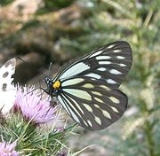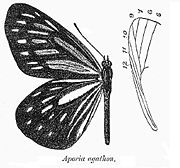
Aporia agathon
Encyclopedia
Great Blackvein , Aporia agathon is a midsized butterfly
of the Family Pieridae, that is, the Yellows and Whites, which is found in India.
 Variety caphusa Moore (Sikkim ; Kumaon ; Mussoorie to Simla and the Kangra region) differs from agathon both on the upper and under sides in the much greater width and extension of the greenish-white markings in the discoidal cells and interspaces of the wings. On the upperside the streak in interspace 1 of the fore wing shows no sign of any black dividing-line, and it, as well as the short streaks of the discal series, show a tendency to coalesce with the subterminal elongate spots. On the underside the spots near apex of fore wing and those on the hind wing are only faintly, not clearly, suffused with yellow ; the chrome-yellow spot at base of the latter as in agathon. Antennae, head, thorax and abdomen as in agathon, the abdomen more dark brown than black.
Variety caphusa Moore (Sikkim ; Kumaon ; Mussoorie to Simla and the Kangra region) differs from agathon both on the upper and under sides in the much greater width and extension of the greenish-white markings in the discoidal cells and interspaces of the wings. On the upperside the streak in interspace 1 of the fore wing shows no sign of any black dividing-line, and it, as well as the short streaks of the discal series, show a tendency to coalesce with the subterminal elongate spots. On the underside the spots near apex of fore wing and those on the hind wing are only faintly, not clearly, suffused with yellow ; the chrome-yellow spot at base of the latter as in agathon. Antennae, head, thorax and abdomen as in agathon, the abdomen more dark brown than black.
Var. phryxe, Boisduval. This is the palest of the series of the varieties of agathon. The intercellular and interspacial greenish- white streaks and spots, which, in var. caphusa, are considerably longer and broader and, so far as the markings in the interspaces are concerned, show a tendency to coalesce, in phryxe become very broad and white, so that the discal series of short streaks on both wings extend to and coalesce completely with the much broadened spots of the subterminal series. In fact, the insect may be described as white both on the upper and under sides, the veins broadly bordered with black, and with black terminal margins formed by the expansion and coalescence of the black at the apices of the veins ; discoidal cell of the fore wing with a large patch of black at the apex. The black along the veins of both fore and hind wing suddenly broadened on the discal area ; on the underside of the hind wing they almost form a connected discal, transverse black band ; the chrome-yellow spot on the precostal area as in agatlion. Antennae black, head and thorax dusky grey, abdomen white ; beneath : head and thorax blackish, abdomen white.
Has a wing expanse of 84-98 mm.
(Mackinnon quoted in Bingham)
Pupa. "Very similar in shape to that of Aporia soracte is greenish-yellow with black markings." (Mackinnon quoted in Bingham)
Food-plant of larva. Berberis nepalensis.
Butterfly
A butterfly is a mainly day-flying insect of the order Lepidoptera, which includes the butterflies and moths. Like other holometabolous insects, the butterfly's life cycle consists of four parts: egg, larva, pupa and adult. Most species are diurnal. Butterflies have large, often brightly coloured...
of the Family Pieridae, that is, the Yellows and Whites, which is found in India.
Description
Typical form has the upperside black; fore and hind wings with the following white or greenish-white streaks and spots in the discoidal cells and in the interspaces. Fore wing : a broad streak in cell, two more or less confluent streaks obscurely divided by a diffuse blackish line below it in interspace 1, followed by an upper discal series of five short lines in interspaces 3, 4, 5 and 10, and a subterminal complete series of elongate narrow spots ; both the discal and subterminal series are curved inwards anteriorly. In most specimens the streaks in interspace 1 and in cell are irrorated with black scales. Hind wing: a broad streak along the dorsum divided by vein 1a, two narrow long streaks in interspace 1, a much broader elongated oval streak in cell, with another elongate broad streak above it in interspace 7, a discal series of five narrow elongate spots apex of cell, followed by a complete subterminal series of more or less oval spots. Underside: ground-colour and markings similar, more clearly defined, and on the fore wing generally broader and whiter, except that the anterior one or two streaks or spots of the discal and subterminal series, like all the markings on the hind wing, are strongly suffused with bright yellow; in addition the precostal area on the hind wing is bright chrome-yellow. Antennae, head, thorax and abdomen black; abdomen beneath white, the anterior legs with one or two white spots.
Var. phryxe, Boisduval. This is the palest of the series of the varieties of agathon. The intercellular and interspacial greenish- white streaks and spots, which, in var. caphusa, are considerably longer and broader and, so far as the markings in the interspaces are concerned, show a tendency to coalesce, in phryxe become very broad and white, so that the discal series of short streaks on both wings extend to and coalesce completely with the much broadened spots of the subterminal series. In fact, the insect may be described as white both on the upper and under sides, the veins broadly bordered with black, and with black terminal margins formed by the expansion and coalescence of the black at the apices of the veins ; discoidal cell of the fore wing with a large patch of black at the apex. The black along the veins of both fore and hind wing suddenly broadened on the discal area ; on the underside of the hind wing they almost form a connected discal, transverse black band ; the chrome-yellow spot on the precostal area as in agatlion. Antennae black, head and thorax dusky grey, abdomen white ; beneath : head and thorax blackish, abdomen white.
Has a wing expanse of 84-98 mm.
Distribution
Found in the sub Himalayan region from Assam, Sikkim, Bhutan, Nepal to Mussoorie and Kumaon in the West.Life history
Larva. "The larvae of A. caphusa are gregarious, and to pupate burrow under the dry leaves at the foot of their food-plant, the pupae being also gregarious. The larvae spin a joint web, and lie together in communities of ten or more. They feed at night only. Colour when full-grown dirty brown, head black, each segment with a dorsal longitudinal dark brown stripe ; the larva is thinly covered with weak white hairs. Just before pupation the colour turns to a light green, with the head and stripes as before."(Mackinnon quoted in Bingham)
Pupa. "Very similar in shape to that of Aporia soracte is greenish-yellow with black markings." (Mackinnon quoted in Bingham)
Food-plant of larva. Berberis nepalensis.

